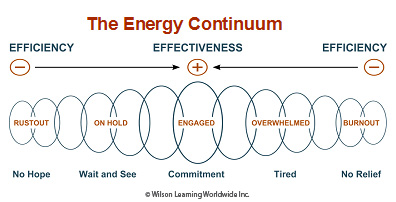Getting Back to Growth Mode
Tips to Re-Engage Your Workforce

Things are looking up. Businesses are starting to grow again, and new opportunities are cropping up slowly but surely. Many companies are adding staff carefully, building the resources necessary to manage this new activity. New business calls for organizations to change their approach and their attitudes around engagement.
Over the last few years, managers and workers were stretched too thin trying to accomplish high levels of work with fewer employees. Whatever companies have maintained or increased, they are still doing more with less. This is good news for CFOs and senior managers, but it comes at a cost. Even if productivity improves, it means people are still stretched too thin. Many employees have reached the point of burnout and are no longer able or willing to give their all every day. But can you get higher productivity without people burning out? Our experience says "yes."
It's important for company leaders to help staff handle all of the changes and choose their level of engagement and how they spend their energy. Change is the constant, whether it's perceived as good or bad, and success relies upon people understanding where and how to commit their energy.
As the Energy Continuum shows, employees with low engagement passively wait to see what comes next. If they perceive no chance for improvement, they slip to the left on the continuum to the state of "rustout," with "no hope." On the opposite extreme, some people are so committed they take on impossible workloads only to become overwhelmed. They reach a point of "burnout" as they experience "no relief." Efficiency is at its lowest ebb in the states of rustout and burnout. Efficiency is maximized when employees manage their discretionary energy carefully, allowing them to stay highly engaged near the point of equilibrium—at the midpoint on the Energy Continuum.
As the continuum illustrates, employees need to see changes that offer hope of relief and renewal in order to re-engage and avoid the results of burnout—reduced efficiency, productivity, and commitment.

Recently, many managers have increased headcount that leaves an organization with new employees, unfamiliar with the work and the processes, leaving part of the team underutilized and the rest overwhelmed and/or overworked. What can you do to energize your team's sense of engagement and commitment? While there are no magic bullets, there are strategies that can help your overextended team engage with each other and their work.
DELEGATE FOR GROWTH
It seems paradoxical to talk about delegation in this context. Give them more work? No. Rather, ask yourself, what is being done that doesn't really need to be done, or done the same way because it's always been done that way? What isn't being done that should be done instead? You may be able to increase capacity with the right mix of new assignments and growth opportunities for your people.
Assess your team:
- Review the current workload and capabilities of your team members.
- Identify areas for individuals to develop new skills and knowledge for growth, or to apply existing skills in new ways.
- Identify unused or underused capabilities and skills that could be put to use on different tasks or priorities.
Assess the workload and look for opportunities to change how goals are being accomplished:
- Look for tasks that are no longer tied closely to strategy or that can be done in a different way. It is easy to fall into a rut where things are being done because they have always been done or have always been done a certain way. By looking at tasks with fresh eyes, you may see that tasks or processes are tied to an old business model or strategic intent and don't need to be done at all. Some of the work could be done very differently—with the use of technology, for example.
- Reassign necessary tasks to new people and give them authority to do them differently. The opportunity to be creative and change what's always been done raises the importance level of the task and provides a chance to do it more effectively.
- Look for new, interesting projects that will provide an opportunity for the right person or people to do something new, expand their skills, and work with different people—possibly across functions. Again, there may be opportunities to apply technology, change a method or process, or make improvements that increase efficiency or productivity. These are satisfying contributions that could have the effect of increasing capacity and fulfillment.
Tips for success:
As you expand horizons with new assignments and projects, keep in mind the delegation basic rules of thumb:
- The task must be seen as a challenge and an opportunity to grow and learn new skills rather than as another burden. The whole effort will backfire if people see this initiative as just more work.
- The goals and expectations are clear and achievable. People working on new tasks or projects need to see they can be successful in carrying out the new tasks or projects.
- Support and resources are clearly available. There is nothing worse than being given a task to do, but lack the resources to meet the goal. This may mean ensuring there are enough people to do the job, the right equipment is available (e.g., computer software), and in some cases, a budget has been allotted, if required.
- There is an appropriate level of autonomy in deciding how to carry out the assignment. Again, the idea here is to empower and engage your team. They need to feel they are being trusted, are free to exercise their judgment and apply their ideas, and are empowered to make decisions and take action. Be ready to provide help without micromanaging.
As with any change, discuss your ideas with the team and gain the support and agreement of the individuals who will be taking on the new responsibilities.
CREATE A COMMUNITY OF SUPPORT
Your employees may be skeptical initially as you undertake a renewal and re-engagement effort. Once you have thought through the plan and the new assignments you have in mind, take time to communicate with the whole team to answer questions, make your goals clear, and get their buy in.
Create a community of support for the effort by developing a sense of collaboration. People who are burned out often lack the energy or motivation to reach out to their peers or colleagues in other functions. Yet working with others, especially new hires, and providing mutual support contributes to an upward spiral of energy and efficiency, helping to reverse declining levels of commitment.
Tips for Success
- Make the group aware of the benefits of mutual support.
-
Look for opportunities for sharing and communication.
- If there is someone on the team with skills or knowledge related to what another team member is working on, encourage that person to share information and create a learning opportunity for the less-experienced or new employee.
- Use team meetings as a venue for people to discuss what they are working on, problems they may be encountering, and successes they have experienced.
- Encourage team members to create a culture of trust by looking for ways to flex, adapt, and show versatility toward the needs of others.
Success in creating a closer, more supportive environment will pay off not only in terms of improved morale and a sense of connection, but will have the added benefits of increased decision-making efficiencies, more and better ideas, and a broader perspective about how to accomplish your group's work, especially as new business comes in and new employees join an existing team.
These ideas are neither rocket science nor easy to achieve. But if your group is recovering from the common symptom of "recession burnout," you can't afford not to take some proactive steps to create a sense of enthusiasm and engagement for the new opportunities among your team members. If you take positive action to shake things up in the right way, you will be able to take advantage of a new work atmosphere, fostering growth for your team, yourself, and your business.
To learn more, contact Wilson Learning at 1.800.328.7937 or complete the online form.







 Please complete this form to download Getting Back to Growth Mode | Tips to Re-Engage Your Workforce.
Please complete this form to download Getting Back to Growth Mode | Tips to Re-Engage Your Workforce.



